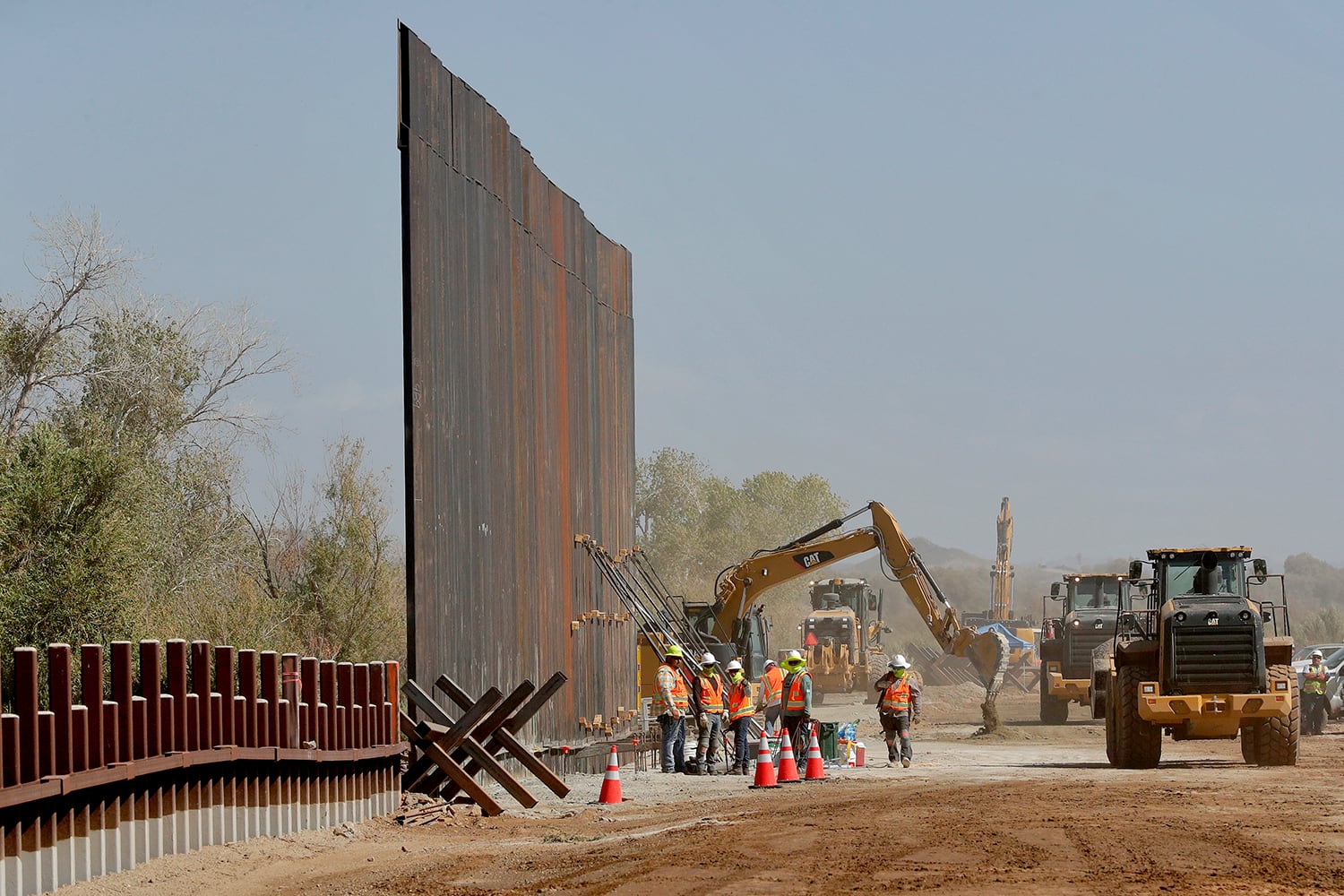Updated 2/13 at 5:25 PM EST with comment from the Pentagon
WASHINGTON — The Pentagon is seeking to divert $3.8 billion, largely from its fiscal 2020 weapons procurement budget, in order to fund President Donald Trump’s border wall, according to a reprogramming request to congress obtained by Defense News.
Among the victims of the cuts: a mass of aircraft purchases including F-35 joint strike fighters, C-130J cargo aircraft, MQ-9 Reaper drones and P-8 maritime surveillance planes, as well as ground vehicles and naval priorities — choices that drew quick, bipartisan condemnation from key defense lawmakers as reports of the plan filtered out Thursday.
Overall, the plan would shift $2.202 billion in FY20 defense appropriations and $1.629 billion in FY20 overseas contingency operations funding towards the wall, a key priority from president Donald Trump ahead of the November presidential elections.
Air Force and Navy aviation spending takes the brunt of the cuts proposed by the Pentagon, with aircraft procurement going down by $558 million for Navy and Marine Corps and $861 million for the Air Force. Importantly, all of the funding decreases target items that were specifically added by Congress during the budgeting process, which could incur rancor from lawmakers.
For the Navy, the Pentagon would cut two of the six F-35B short takeoff and landing aircraft added to the FY20 budget by Congress and two MV-22 Ospreys, stating that “current funding is more than sufficient to keep the production line open.” It also seeks to eliminate funding for one of the nine P-8A Poseidon surveillance aircraft funded in FY20, stating that the additional aircraft is “[in] excess to the 117 aircraft required.”
In the Air Force’s budget, the Pentagon slashed funding for four of the eight C-130Js added by Congress for the Reserve and Air National Guard. The department stated that funding for those planes can be rescheduled to fiscal year 2021, when the period of performance for the associated contract starts.
The request would eliminate eight MQ-9 Reaper drones, culling most of the funding added by Congress for an increase of 12 MQ-9s. “The program is currently undergoing a strategic review,” the department stated in written justification, referring to an ongoing debate within the Air Force about how many Reapers to buy and retain over the next decade. “Procurement, if necessary, can be rescheduled to a later fiscal year.” Combatant commanders have consistently said they need more surveillance assets around the globe.
It also strips $156 million for advanced procurement for the F-35A and removes $180 million for light attack aircraft for the Air Force, which the service has decided against procuring but has been widely supported by lawmakers as a low-cost alternative for the counter-terrorism fight.
The Army would stand to lose $100 million in funding for National Guard Humvee modernization and $194.5 million in Heavy Expanded Mobility Tactical Truck funding. However, with the Humvee set to be replaced by JLTV, the Army is unlikely to be heavily impacted by these funds being shifted around.
The reprogramming request also cuts $650 million in advanced procurement funding for an America-class Amphibious Assault Ship, LHA-9, which is being built in Mississippi at Ingalls Shipbuilding. On its website, Huntington Ingalls Industries says the advanced funding provided by Congress, “enables a hot production line and a supplier base of 457 companies in 39 states to build this powerful warship.”
The reprogramming also cuts funding one expeditionary fast transport ship, which is built in Alabama at Austal USA, which has been an area of interest for the powerful Republican chairman of the Senate Appropriations Committee, Sen. Richard Shelby. The ship was deemed “excess to current programmatic need,” the reprogramming document says.
“The procurement exceeds the program-of-record requirement,” the document reads. “This is a congressional special interest item.”
In addition, the National Guard and reserves would lose about $1.3 billion in what the reprogramming request describes as unnecessary funding, given historic underexecution of prior year funds.
RELATED

Congressional reaction
Last year, the Defense Department had budgets, largely for military construction projects, diverted into funding a stretch of the wall project. Those project cuts included the rebuilding of several DoD schools both in the U.S. and abroad, special operations training centers in Europe and Hurricane Maria relief for Puerto Rico National Guard facilities. Overall, more than 100 projects had funding delayed.
Asked on Tuesday about a potential reprogramming of defense funds to pay for the wall, Secretary of Defense Mark Esper said: “We did receive the request from DHS, that’s all I’ll say right now. We’re working our way through the process, we’re doing all those things we need to do. So when we’re ready to make an announcement, we’ll make an announcement.”
Both Democrat and Republican leaders immediately criticized the move as an attempt to usurp Congress’ power of the purse that would endanger national security.
House Appropriations Committee Chairwoman Nita M. Lowey, D-N.Y., and Defense Appropriations Subcommittee Chairman Pete Visclosky, D-Ind., said in a joint statement that Trump was, “once again disrespecting the separation of powers and endangering our security by raiding military resources to pay for his wasteful border wall,” and “orchestrating this backdoor mechanism to prop up a political vanity project.”
In a separate statement, Texas Rep. Mac Thornberry, the top Republican on the House Armed Services Committee, said he supports building a border wall, but slammed the Pentagon for going against congressional direction for spending defense dollars, saying the unilateral movement of already approved spending by Congress “undermines the principle of civilian control of the military and is in violation of the separation of powers within the Constitution.”
“The re-programming announced today is contrary to Congress’s constitutional authority, and I believe that it requires Congress to take action," Thornberry said. "I will be working with my colleagues to determine the appropriate steps to take.”
In a statement, Pentagon spokesman Lt. Col. Chris Mitchell "The Department of Defense is committed to supporting the Department of Homeland Security’s efforts to secure the southern border by constructing fences and roads and installing lighting to block drug smuggling corridors.
“Last month we received a new request from the Department of Homeland Security asking for assistance in blocking drug-smuggling corridors on Federal land along the southern border of the United States," Mitchell said. "In response, the Secretary of Defense authorized support of $3.8B to build approximately 177 miles of fencing that will help to protect our borders. We will continue to support DHS and other agencies as needed to keep our homeland is secure.”
Jen Judson in Washington contributed to this report.
Aaron Mehta was deputy editor and senior Pentagon correspondent for Defense News, covering policy, strategy and acquisition at the highest levels of the Defense Department and its international partners.
Valerie Insinna is Defense News' air warfare reporter. She previously worked the Navy/congressional beats for Defense Daily, which followed almost three years as a staff writer for National Defense Magazine. Prior to that, she worked as an editorial assistant for the Tokyo Shimbun’s Washington bureau.
David B. Larter was the naval warfare reporter for Defense News.
Joe Gould was the senior Pentagon reporter for Defense News, covering the intersection of national security policy, politics and the defense industry. He had previously served as Congress reporter.




